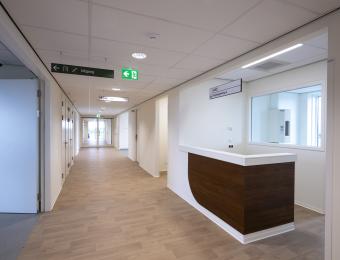
Verhuizing naar nieuw ziekenhuisgebouw verschuift naar 2026
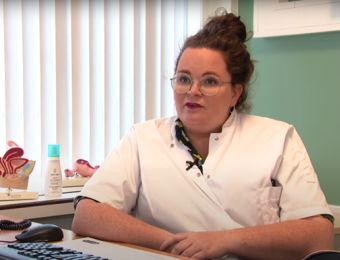
“Het is zonde om met klachten rond te blijven lopen” - Ghislaine Dekeunink vertelt bij L1 over overgangsklachten

Massage the milk ducts and milk glands by gently pressing towards the nipple with a flat hand. Move your fingers from the side of your breast towards the center, whilst making a circular pressing motion. Concentrate the movements on one single part of the breast before moving on to another section. Slowly move towards the areola in circular motions.
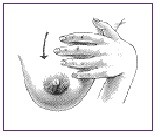
Gently press from the top of the breast towards the areola. Try to relax and take some deep breaths. This will also stimulate an easier let-down of milk.
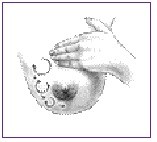
Another thing that can help stimulate a let-down is to utilize the help of gravity, by leaning forward and gently shake the breast in a side-to-side motion.
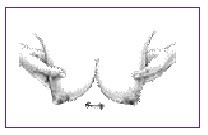
Always be gentle!
1. Do not squeeze the breast, this could cause bruising of the breast tissue.
2. Do not let your hands ‘glide’ over the breast, this could irritate the skin
3. Do not pull the nipple, this could also cause damaging of the breast tissue.
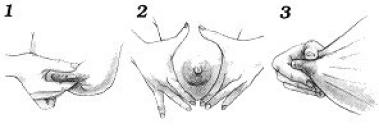
During your stay it’s advised that you use the breastpump provided to you by the hospital. The Medela Symphony that’s provided has two different programs to help initiate milk production. Below you will find some more information about the different programs and how to use them.
The Initiate program is developed particularly for the first days after giving birth, and is meant to stimulate and initiate the milk production. This program is fully automatic and will stop after 15 minutes.
To activate the Initiate program you press the left ‘on’ button to turn on the Symphony breastpump. Within 10 seconds of pressing the ‘on’ button you press the right ‘droplets’ button to start the Initiate program. When the screen shows the text: ‘Initiate loopt’ the program has started and you can use the dial in the middle to increase the suction levels to 3 or 4 droplets, whichever is most comfortable for you.
Starting 24 hours after birth, it is advised to use a combination of the Initiate and the Maintain program. Research has shown that this increases milk production faster than just using the Initiate program in the first few days. The best way to do this is to start with the 15 minute Initiate program, and to follow up with 5 minutes of pumping on the Maintain setting.
Once your milk has started coming in it is time to switch to the Maintain program. This is a two fase pumping setting that starts with 2 minutes of fast paced pumping with low suction to stimulate a let down reflex, followed by a continuous slower pace with higher suction levels. This program is most effective in fully emptying the breast which will further increase your milkproduction to the desired amount.
It’s best to fully switch to the Maintain program when:
To activate the Maintain program you first press the left ‘on’ button on the Medela Symphony. After 10 seconds the screen will display the text: ‘Maintain loopt’. You can then turn the dial in the middle to adjust suction levels to your personal preference. The Maintain program stops after 30 minutes, but for most mothers 15 minutes is enough to fully empty the breast. If after 15 minutes the milk still flows quite fast and your breast feel full, you may want to continue for a few minutes longer until the milk only comes out in drops.
If you do not have access to a hospital grade breastpump, it is possible to initiate the milkproduction by doing the following:
When using a single-handed pumpset, stimulate a let-down reflex by:
By alternating between the left and right breast it is possible to trigger multiple let-down reflexes. This helps to stimulate adequate milk production. The times mentioned above are a guideline. If it’s not possible to pump for 5 consecutive minutes, or when there’s no visible milkproduction whilst pumping, the best option is to pump more frequently for shorter periods of time (an example: 3-4 times of 3 minutes per breast). If you do this, try to at least pump for 10 minutes per breast in total.
When using a double-handed pumpset, stimulate a let-down reflex by:
OR:
Hygiene is extra important when the pumped mothermilk is used to feed a premature or sick baby. Good hygiene prevents bacterial growth. Mothermilk is a well preservable product because it contains living white bloodcells (among other things) which reduces the amount of bacteria in the milk, even when stored. When the mothermilk is stored and transported under the best possible circumstances it is preservability greatly increases!
Guidelines:
Thoroughly wash your hands with water and soap before using your breastpump. In the hospital, make sure you dry your hands with paper towels. At home, it’s best to use a separate towel which you change daily.
The hospital will provide you with sterile bottles to preserve your mothermilk. Try not to touch the inside of the bottles or caps.
It’s best to wash your (nursing)bra on a daily basis. If you use breast pads, change these every time you pump or feed your baby.
It is not necessary to wash your nipples before pumping. Taking a shower once a day is enough to keep your breasts clean.
Do not use soap or lotions on your breast, especially not on the areola and nipple. The areola has little glands that produce a greasy substance, which helps keep the areola soft and works antiseptic.
Clean the parts of your breastpump well after every use by rinsing the loose parts with cold water first, then warm water after. You can use some washing up liquid or put the loose parts in the dishwasher (check the user manual if this is possible for your pumpset!). After washing up, make sure you dry every part completely and store everything in a clean and dry cotton (dish)towel or sealed box until you pump again. The pumpset has to be sterilized once a day for 10 minutes, which you can do by boiling it.
During your stay in the hospital you will receive a sterile pumpset. This pumpset is to be sterilized once every 24 hours in the microwave. Hospital staff can inform you on how to do this.
Mothermilk can be heated up under hot running water, in a bottle-warmer or in a small pan filled with warm water.
If possible, do not heat up breastmilk in the microwave. Valuable ingredients of the milk can get broken down at a temperature of 55°C.
Any remaining breastmilk that has already been heated up cannot be preserved or reheated.
|
Temperature |
Shelf life | |
| Freshly pumed milk |
Room temperarture |
6 - 10 hours |
| Freshly pumed milk |
Refrigeratie at home |
at least 72 hours |
| Freshly pumed milk |
Hospital refrigerator |
48 hours maximum |
| Cooled down mothermilk |
Freezer compartment in the refrigerator |
2 week maximum |
| Cooled down mothermilk |
(small) freezer that opens and closes often |
3 - 4 months |
| Cooled down mothermilk |
Freezer cibstabt temperature -18°C or colder |
6 months or longer |
| Defrosted mothermilk |
Refrigerator |
24 hours maximum |
| Defrosted mothermilk | Room temperature | Use immediately |
Caution! Do not keep pumped mothermilk in the refrigerator door because of greater fluctuations in temperature when opening.
A professional electric breastpump is an expensive appliance. Because most mothers only need a pump for a short duration of time, renting can be a good alternative.
The vrouw- moeder- kindcentrum rents out Medela breastpumps. These are the same kind of pumps that you can utilize during your hospital stay. If there is a pump available, you can take the breastpump home immediately upon discharge and pay afterwards. You can return the breastpump to the Vrouw- Moeder- Kindcentrum when you no longer need it, this is possible 7 days a week. After you return the breastpump to the hospital the bill for the total owed amount will be send to your home address.
Other options for renting a breastpump are:
Medicura
Maaspoort 64
Weert
Telephone: 088 - 00 71 100
Medipoint Zorggroep
Kempweg 33
Roermond
Telephone: 088 – 10 20 100
Zuidzorgwinkel
De Dam 1
Budel
Telephone: 040 – 25 03 838
Vegro Uitleenpunt
Veldstraat 1
Roermond
Telephone: 0900 – 288 77 66
Any more questions?
If you have any remaining questions after reading this brochure,you may always ask te lactation consult of the VMK for more information.
More information can also be found at:
Breastfeeding organisatie La Leche Legue
https://www.lalecheleague.nl/
https://www.llli.org/breastfeeding-info/
The Dutch union of Lacttation Consultants (Nederlansde Vereniging Lactatiekundigen)
www.nvlborstvoeding.nl
Trustworthy online information:
www. borstvoeding.com
ibconline.ca
https://www.who.int/health-topics/breastfeeding
https://icea.org/breastfeeding-information-on-the-internet-the-good-the bad-and-the-ugly/
This Pumping journal belongs to: _________________________________
You can fill in this journal, if desired with help of the nursing staff, to keep track of your pumping session. This may help to keep track of your milk production and give you the best possible advice in your personal situation.
Name of baby:
Day 1: date:...................................................Breast pump: O single O double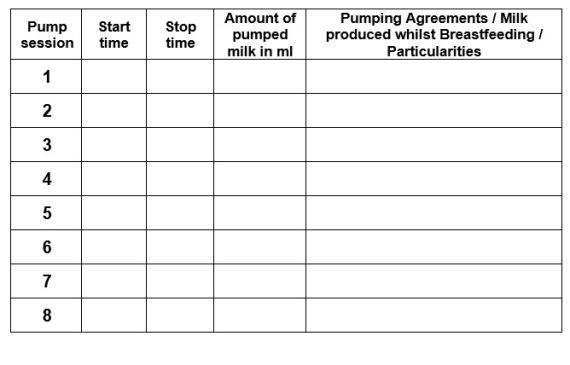
Day 2: date....................................................Breast pump: O single O double
Day 3: date ...................................................Breast pump: O single O double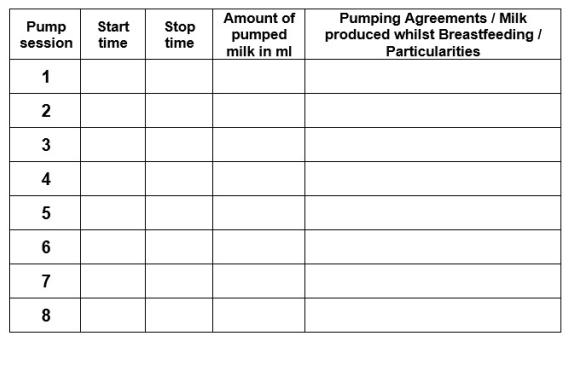
Day 4: date................................................... Breast pump: O single O double
Day 5: date:..................................................Breast pump: O single O double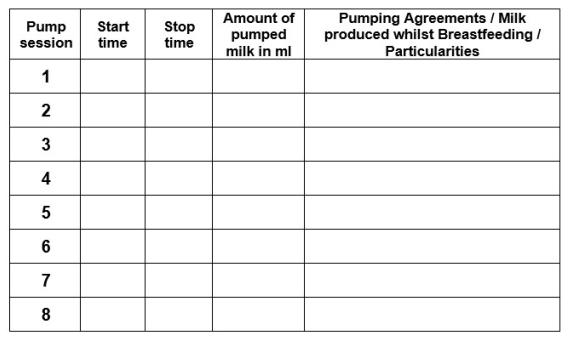
Day 6: date:...................................................Breast pump: O single O double
Day 7: date:.................................................. Breast pump O single O double
Day 8: date:...................................................Breast pump: O single O double
Day 9:date:....................................................Breast pump: O single O double
Day 10: date:.................................................Breast pump: O single O double
Day 11: date:.................................................Breast pump O single O double
Als u na het lezen van deze brochure nog vragen heeft, kunt u deze stellen aan de lactatiekundige van het VMK.
Borstvoedingorganisatie LLL
Postbus 212
4300 AE Zierikzee
Tel: 0111 – 41 31 89
www.lll.borstvoeding.nl
Nederlandse Vereniging Lactatiekundigen
www.nvlborstvoeding.nl
Betrouwbare informatie:
www.borstvoeding.com


